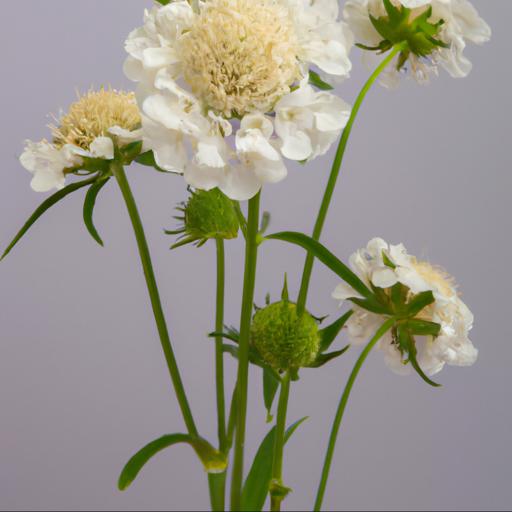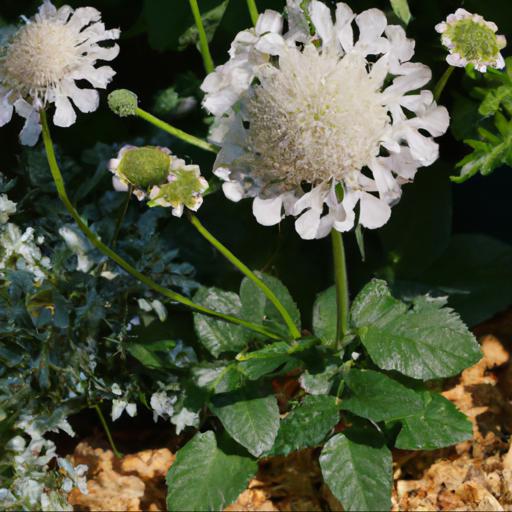Scabiosa caucasica perfecta alba, commonly known as the “pincushion flower”, is a beautiful and unique flower that has been delighting gardeners for centuries. With its distinct and delicate white petals, this flower is a stunning addition to any garden. Its long stems and fragrant blooms make it a popular choice for flower arrangements and bouquets.
Scabiosa caucasica perfecta alba is also a great choice for container gardens, as its small size and hardiness allow it to thrive in a variety of conditions. Whether you’re looking to add a touch of beauty to your outdoor space, or in need of a unique and fragrant cut flower, Scabiosa caucasica perfecta alba is sure to bring joy to your garden.
Benefits of growing scabiosa caucasica perfecta alba

As a UK garden expert, I can proudly say that the Scabiosa caucasica perfecta alba or the White Perfecta is a fantastic variety of perennial flower that boasts a host of impressive features making it a worthy addition to your garden. This striking flower attracts pollinators from far and wide, making it an excellent choice for those looking to contribute to a local eco-system. Its flower centers in particular, show off an impressive array of bright yellow anthers, making them particularly visible for potential pollinators.
Whether your garden is formal or informal, the flower’s dainty, slender petals and its sweet fragrance will be impossible to ignore. These flowers are relatively easy to maintain and need little attention, preferring well-drained soil and regular dead-heading.
The white Perfecta will thrive in full sun and partial shade, making it a great choice for gardens of various sizes and levels of light. This flower is considered to be hardy and will bloom throughout the spring and summers months, adding a splash of colour and scent to your outdoor space. For UK gardeners looking to enjoy a beautiful, long lasting, and low maintenance flower, I highly recommend the Scabiosa caucasica perfecta alba or the White Perfecta.
It is sure to add a delightful touch to any garden, sure to bring great pleasure year after year.
Tips for planting and caring for scabiosa caucasica perfecta alba

Gardening experts know that the Scabiosa caucasica perfecta alba is an elegant and graceful addition to any garden. With its soft, creamy white petals that are arranged in an outwardly fanning pattern, it’s the perfect flower to centerstage in many spring and summer gardens. But with its dainty and fragile appearance, it is important to know how best to plant and care for it in order to get the most out of your blooms.
First and foremost, the Scabiosa caucasica perfecta alba needs full sun and well-drained soil that is slightly on the alkaline side. The correct soil pH is
0 and above. If planting more than one type of Scabiosa caucasica perfecta alba, make sure to give each enough room to grow by spacing them three feet apart.
The plant can reach two feet in height and width, but will generally stay much smaller in the home garden. Once the Scabiosa caucasica perfecta alba is planted, you’ll be rewarded with a dazzling array of blooms. To keep it healthy and vigorous, it’s best to fertilize every three to four weeks with a liquid fertilizer, and water regularly to keep the soil moist.
Deadheading spent blooms regularly will help to keep the plant looking beautiful and produce more flowers. Lastly, the plant is vulnerable to pests such as aphids, so keep an eye out for insect infestations. By following these simple planting and care instructions, you can enjoy the Scabiosa caucasica perfecta alba in your garden for many seasons.
With its lacy foliage and exquisite white flowers, it’s sure to become the focal point of your garden and an eye-catching addition to any landscape.
Common pests and diseases of scabiosa caucasica perfecta alba

Scabiosa caucasica perfecta alba, commonly known as the white pincushion flower, is a popular perennial for UK gardens. This variety of scabiosa is a low-maintenance, drought tolerant beauty that adds striking white blooms to your garden in the late summer to early autumn months. While these flowers are generally easy to take care of, they are not immune to common pests and diseases.
The most common pest affecting scabiosa caucasica perfecta alba is the cabbage white butterfly. These butterflies lay their eggs on the undefended foliage and their larvae feed on its leaves.
To deter the butterfly, cover plants with a physical barrier such as a beekeeping net. Also helpful are water sprays with insecticide soap or neem oil mixed into it.
Another common pest is aphids. These small, pear-shaped bugs feed on the sap of the plant and can stunt its growth. To help control these, use an insecticide soap.
Another option is to remove them manually and then apply a water spray with neem oil–an all-natural pesticide. Lastly, scabiosa caucasica perfecta alba is susceptible to powdery mildew. This fungal disease typically shows up in the form of white or gray patches on the leaves of the plant.
To treat this, use an approved fungicide, or simply water the plant with a mixture of water and baking soda. Overall, scabiosa caucasica perfecta alba is a beautiful, easy-going flower.
However, it is not immune to common pests and diseases. Thankfully, with monitoring and the right treatment, you can help protect this stunning floral addition to your garden.
How to use scabiosa caucasica perfecta alba in landscaping
Using Scabiosa caucasica perfecta alba in landscaping is a popular way to bring a unique and striking theme to your garden that celebrates both tradition and nature. Scabiosa caucasica perfecta alba, commonly called ‘perfect white’, is a species of perennial flowering plant native to the Caucasus mountains in Georgia. The plant is a beautiful sight in landscaping, with its dark green leaves and delicate white pincushion-like flowers.
Scabiosa caucasica perfecta alba can be used to create simple but striking hedges, borders and walkways in your garden. As it is a perennial and can survive even in cold climates or during winter, it is ideal for planting in any season.
When used in planting designs, the plant can be used to create a shade of white or light grey, which stands out wonderfully against a contrastingly dark backdrop. Regardless of size or purpose, scabiosa caucasica perfecta alba can enhance any garden environment. Along with its striking white flowers, the plant also attracts pollinators like bees, butterflies and birds which can enhance biodiversity in the garden.
Furthermore, the plant can also be used in containers as a way to bring a modern look to the home, providing a beautiful fixture indoors or out.
Bottom Line
Scabiosa caucasica perfecta alba is a beautiful and unique plant that adds a special touch to any garden. It is a perennial plant with white flowers and striking foliage.
This plant is easy to grow and maintain, and it is drought tolerant. It can also be used as a cut flower and is a great addition to any garden. Its unique beauty and hardiness make it a great choice for gardeners of all levels.
FAQ
What is the scientific name of Scabiosa caucasica perfecta alba?
The scientific name of Scabiosa caucasica perfecta alba is Scabiosa caucasica ‘Perfecta Alba’.
Where is Scabiosa caucasica perfecta alba native to?
Scabiosa caucasica perfecta alba is native to the Caucasus region of Eurasia.
What are the characteristics of Scabiosa caucasica perfecta alba?
Scabiosa caucasica perfecta alba is a perennial flowering plant with white, saucer-shaped flowers. It has a long flowering period, typically from late spring to early autumn, and is attractive to butterflies and bees. The plant has a mounding habit and grows to a height of up to 60 cm. Its foliage is dark green and deeply divided.
How tall does Scabiosa caucasica perfecta alba grow?
Scabiosa caucasica perfecta alba typically grows to a height of 1-2 feet.
What type of soil does Scabiosa caucasica perfecta alba prefer?
Scabiosa caucasica perfecta alba prefers well-drained, slightly acidic soil with a pH of 6.0 to 7.0.
How often should Scabiosa caucasica perfecta alba be watered?
Scabiosa caucasica perfecta alba should be watered regularly, about once a week or when the soil is dry to the touch.

